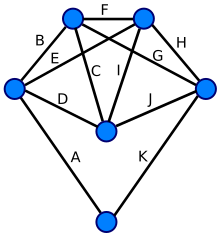

In graph theory, an Eulerian trail (or Eulerian path) is a trail in a finite graph that visits every edge exactly once (allowing for revisiting vertices). Similarly, an Eulerian circuit or Eulerian cycle is an Eulerian trail that starts and ends on the same vertex. They were first discussed by Leonhard Euler while solving the famous Seven Bridges of Königsberg problem in 1736. The problem can be stated mathematically like this:
- Given the graph in the image, is it possible to construct a path (or a cycle; i.e., a path starting and ending on the same vertex) that visits each edge exactly once?
Euler proved that a necessary condition for the existence of Eulerian circuits is that all vertices in the graph have an even degree, and stated without proof that connected graphs with all vertices of even degree have an Eulerian circuit. The first complete proof of this latter claim was published posthumously in 1873 by Carl Hierholzer.[1] This is known as Euler's Theorem:
- A connected graph has an Euler cycle if and only if every vertex has even degree.
The term Eulerian graph has two common meanings in graph theory. One meaning is a graph with an Eulerian circuit, and the other is a graph with every vertex of even degree. These definitions coincide for connected graphs.[2]
For the existence of Eulerian trails it is necessary that zero or two vertices have an odd degree; this means the Königsberg graph is not Eulerian. If there are no vertices of odd degree, all Eulerian trails are circuits. If there are exactly two vertices of odd degree, all Eulerian trails start at one of them and end at the other. A graph that has an Eulerian trail but not an Eulerian circuit is called semi-Eulerian.
- ^ N. L. Biggs, E. K. Lloyd and R. J. Wilson, Graph Theory, 1736–1936, Clarendon Press, Oxford, 1976, 8–9, ISBN 0-19-853901-0.
- ^ C. L. Mallows, N. J. A. Sloane (1975). "Two-graphs, switching classes and Euler graphs are equal in number" (PDF). SIAM Journal on Applied Mathematics. 28 (4): 876–880. doi:10.1137/0128070. JSTOR 2100368.